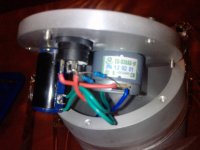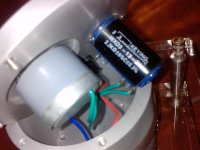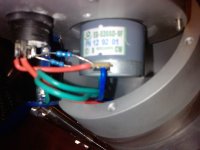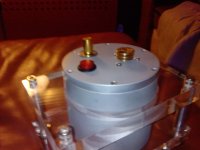Belt location on the platter cannot influance motor load in any way,unless the diameter of the platter changes from top to bottom. but then speed will change too.
The only issue i see here is centering the force applied by the belt with the center of the bearing so the bearing will be loaded evenly, so wear will be minimal.
What Ben said, unless you have huge belt tension you are unlikely to upset the apple cart. A decent inverted bearing, yours is that design, should be self stable as the mass in beneath the point of contact.
Nothing to worry about.
If it's the TB21 that you've bought it should be fine. It'll be interesting to see the motor and controller to give advice on improving that. If it is a DC motor it should at very least use a simple current sensing feedback loop to control the speed stability. Do you have any pics of the PSU and motor?
If it's the TB21 that you've bought it should be fine. It'll be interesting to see the motor and controller to give advice on improving that. If it is a DC motor it should at very least use a simple current sensing feedback loop to control the speed stability. Do you have any pics of the PSU and motor?
I've added some motor pics & as far as I can see there's just the potentiometer & a couple of resistors. I always knew this knew this would take a bit of tinkering to get it as good as it can be so any help is great. Help with the motor would be great too, although I am surprised at how quiet the motor is & the very low background noise & rumble from the turntable in general. The motor only has 5.5v wall wart type psu. Any advice on improvements I could make are very much appreciated. Thanks to everyone that has responded so far.




Last edited:
Ok, looks like it's just a straight DC motor controller with no regulation on there at all. There's plenty that you can do for it, but not much that will fit in the motor housing. It would benefit from a simple current sensing DC motor controller. I imagine there are examples on the forum somewhere.
Ok, looks like it's just a straight DC motor controller with no regulation on there at all. There's plenty that you can do for it, but not much that will fit in the motor housing. It would benefit from a simple current sensing DC motor controller. I imagine there are examples on the forum somewhere.
I had been looking at controllers already but they're way beyond my electrical capabilities. I can't even read a schematic!!! I'm OK with mechanical tinkering but the only thing I could build for the controller is its case as I work in sheet metal. A step by step picture guide with a full parts list might work but couldn't find any last night. At least now I know I know it has no feedback, which I didn't before & I also found some info on the motor. Thanks SQ
How about something like this? None seem to mention any form of feedback but that might be because they assume I should know its there!!! 
http://www.ebay.co.uk/itm/New-DC-6V...ial_Automation_Control_ET&hash=item35bf09c831
http://www.ebay.co.uk/itm/New-DC-6V...ial_Automation_Control_ET&hash=item35bf09c831
Last edited:
This may be a silly question, but would any of the DC motor speed controllers be better than nothing on my motor? Obviously I would have to find a 9v one first as they all seem to start at 12v. I can make casework for it at work. Thanks
If this is the timaudio motor pod it has an integral speed controller built into the motor. Speed stability is OK in my limited experience. (I gave one away with a diy TT that I designed to use it, the recipient as far as I know is still using it regularly.)
If this is the timaudio motor pod it has an integral speed controller built into the motor. Speed stability is OK in my limited experience. (I gave one away with a diy TT that I designed to use it, the recipient as far as I know is still using it regularly.)
You are right, stability is OK for the price but I'd still like to improve it even with my limited electronic ability. You have given me a bit more confidence in it though, I have to admit.
I'm doubtful that you would achieve any meaningful improvement, the motor itself I suspect has relatively modest performance. Just don't overload it as you have noted, print out a stroboscope at Vinyl Engine | The Home of the Turntable, enjoy your new table, and when that motor does finally wear out perhaps go for something like this: Origin Live | Turntable Power Supply (note that I have not tried one, and they are not without some controversy, and the kit is likely to be costly unless you can find a used one somewhere)
A simple pulse width controller like the eBay one probably isn't going to be your best bet. if your motor has a controller built into the bottom of the motor body then it's not going to work with an additional control.
I would follow Kevins advice, print out a strobe disc, check how accurate the speed is and then live with it for a while before trying to improve it. The issue you have is that all good DC motor controls will need adjusting to your chosen motor and that will mean tinkering with the circuit to +/- the speed of the feedback loop and or the current sensing resistor.
I would follow Kevins advice, print out a strobe disc, check how accurate the speed is and then live with it for a while before trying to improve it. The issue you have is that all good DC motor controls will need adjusting to your chosen motor and that will mean tinkering with the circuit to +/- the speed of the feedback loop and or the current sensing resistor.
Well, great advice everyone. Now I know what I'm aiming for, learning to build my own or a kit from somewhere. I have tried a strobe disc & it does seem pretty stable. I think paranoia sets in sometimes, because it didn't cost as much as an origin live, I automatically assume it must be rubbish. Thanks everyone.
Live with it for a while. get to know how it sounds then think about how you might like to improve it.
Thats the way to go I think. Its finally on its proper stand now so I can do some serious listening.
- Status
- This old topic is closed. If you want to reopen this topic, contact a moderator using the "Report Post" button.
- Home
- Source & Line
- Analogue Source
- Turntable bearing question.